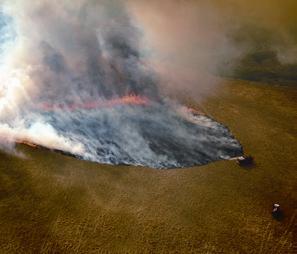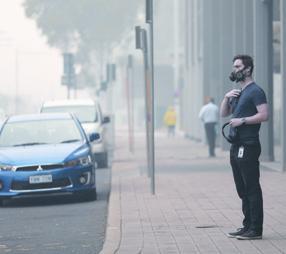The Australian Warning
2020-02-17ByWangRuibin
By Wang Ruibin
Australias catastrophic bushfires have been burning across the continent for over the last couple of months, destroying towns and communities. At least 28 people have been killed so far and more than 10 million hectares burned down since September 2019. The economic loss is estimated at about $3.35 billion and the infrastructure has sustained huge damage.
Still the fires continue to rage out of control. Across the world, there are prayers for rain for much-needed relief.

Underlying causes
What are the underlying causes of this unprecedented devastation in the history of Australia? The immediate cause appears to be the extreme weather conditions this summer—high temperatures, the super dry air, strong winds and scanty rainfall. A sustained drought, which has gripped the country for three consecutive winters, has made forests and bushes drier and more fl ammable than ever.
Climate change has intricate impacts on the environment in many ways. Though Australia holds one of the best national climate records in the world for more than 100 years, according to historical data, average temperatures have risen by 1 degree Celsius since 1910. The country is currently experiencing one of its driest seasons in the last fi ve decades.
The governments climate policy is inadequate, still dominated by fossil fuel interests. The oil and gas industry lobby spent millions of dollars trying to deter the federal government from introducing more clean-energy and positive climate policies.
According to the Department of Industry, Innovation, and Science, Australia is expected to surpass Qatar as the worlds largest liquefied natural gas (LNG) producer. LNG production and processing for export has risen rapidly, leading to substantial increase in greenhouse gas emissions, especially after the government abolished a national carbon pricing mechanism in 2014.
Prime Minister Scott Morrison, who came into offi ce in 2018, further reversed the policy for cutting the emissions. The current worst-case scenario predictions suggest that national emissions will increase until 2030 under the current policies. Australia is likely to fall short of its commitments to the 2015 Paris Agreement on climate change.
The wildfires are the latest climatechange alert for humanity. People still remember the Amazon rainforest fires in Brazil and the California wildfi res in the U.S. last summer. Facts show that the pace of climate change is accelerating.
Act now
The landmark Paris Agreement to set out a new global framework to fight dangerous climate change seems to have effected nothing much so far. There is no real cooperation among countries and no meaningful negotiations. The annual UN climate conference, COP25, closed with a vacuous statement in Madrid in December 2019. Almost 200 countries made little progress in hammering out rules for implementing the Paris Agreement.
According to reports from Climate Action Tracker, an independent scientific analysis that tracks climate action and global efforts, just eight countries have offered pledges to cut emissions suffi cient to meet the Paris Agreement to contain global warming rise by 2 degrees Celsius at the most, with a desire for 1.5 degrees Celsius. All others are insuffi cient, highly insuffi cient or critically insuffi cient. Under the current pledges, the world will get warmer by 2.8 degrees Celsius by the end of the century, close to twice the limit agreed on in Paris. Some governments are even further from the Paris temperature limit in terms of their real-world action, which would see the temperature rise by 3 degrees Celsius.

It is not surprising that the Paris Agreement is in jeopardy. Addressing climate change is a collective-action issue, an urgent, complex global challenge, and needs mutual trust and cooperation among the major countries. But the current international situation is complicated. The U.S. has fi led paperwork to begin the process of withdrawing from the pact, dealing a major blow to international climate cooperation.
Under the Paris Agreement, all member countries agreed to set goals for cutting greenhouse gas emissions on a voluntary basis without any monitoring and enforcement mechanism. Each partys pledge—known as nationally determined contributions or NDCs—is not legally binding. Recent reports have revealed that the current commitments expressed in the NDCs are insufficient to meet the agreements goal of keeping global temperature rise below 2 degrees Celsius. On the contrary, we are using more oil and gas and greenhouse gas emissions have risen by roughly 3 percent each year globally.
Green fundraising has become an uphill task. The Green Climate Fund (GCF) established in 2010 had the goal of mobilizing$100 billion per year by 2020. But it has always been struggling to raise the promised money from economically developed countries, some of which are reluctant to help the people who are the most impacted.
U.S. President Donald Trump has since withdrawn $2 billion of the $3 billion that was promised before. Two rounds of fundraising produced less than $20 billion for developing nations. There is still a serious funding gap to support green projects for the 2020-23 period.
Critical actors
Australias bushfi res are a warning to arouse awareness of ecological and environmental protection globally and move international climate cooperation forward.
Efforts should be intensified to tap the potential for cooperation among major countries that are not only the biggest carbon emitters but also have global or regional clout. Their stance will have great impact on the global climate change governance system. With the goal of building a community with a shared future for humanity, signifi cant progress has been made in climate and clean energy cooperation between China, Brazil, South Africa, India and the EU.
The China-U.S. climate cooperation will exert a great impact globally. China and the U.S. account for around 40 percent of all the carbon dioxide emitted in the world today. The two recently signed a phase-one economic and trade deal, which will have a positive effect on stabilizing the overall relationship and could enhance bilateral partnership on clean energy and climate change.
Multilateralism needs to be followed with the authority of the UN maintained. There are serious fl aws in the Paris Agreement, but we should respect and safeguard the accomplishments so hard won by the international community. All parties to it should speed up settlement of the remaining issues on implementation rules, an important basis for putting the pact into practice.
Also, all actors—state, sub-national and non-state—should be encouraged to play a more active role in taking climate actions like mitigation, adaptation and supporting activities. Local governments, cities and businesses represent a great portion of the global economy and population. In the absence of federal policies in some countries, like the U.S. and Australia, these actors are critical for achieving national goals and the Paris Agreements goals for reducing emissions.
